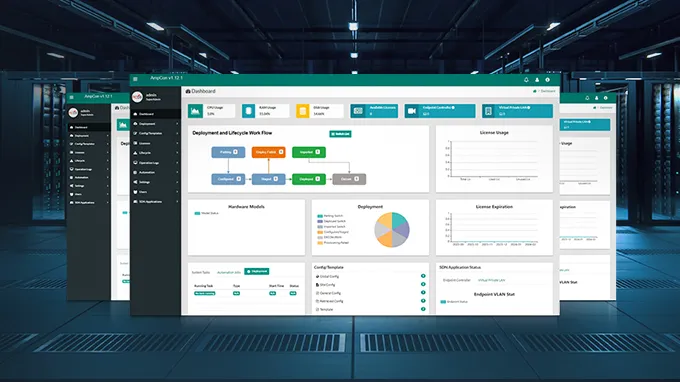The Role of PBR in the Evolution of Network Technology
In modern network management, optimising traffic forwarding is essential, especially as network complexity increases with concurrent applications. Policy-Based Routing (PBR) offers flexible traffic management, allowing organisations to maximise existing resources without expanding capacity, thus reducing operational costs. Compared to traditional routing, PBR provides more precise control, helping organisations meet complex network demands. This article will explore how PBR works, its advantages, and how it can help build smarter, more efficient networks.
How PBR Works
PBR works by defining match conditions and actions to identify and handle data packets. These match conditions can include source addresses, destination addresses, protocol types, and port numbers, while the actions determine how packets are processed, such as specifying the forwarding path or adjusting priority. For instance, PBR can be configured to route HTTP traffic along one path while directing other traffic via another. This flexibility allows network administrators to control traffic routing in a more granular way, ensuring optimised use of network resources and enhanced performance.
How PBR Differs from Traditional IP Routing
Unlike traditional IP routing, which relies solely on shortest path algorithms or default routing tables to determine traffic forwarding, PBR enables greater control by allowing traffic to be routed based on custom policies. Traditional IP routing generally selects the optimal path automatically based on network topology and dynamic routing protocols like OSPF or BGP, aiming to transport packets from source to destination in the most efficient way possible.
However, PBR offers more nuanced control, allowing network administrators to classify and route traffic according to specific business needs. For example, while traditional routing would treat all traffic uniformly, PBR can prioritise critical applications like video conferencing to use high-bandwidth, low-latency links, while directing less critical traffic along alternative paths. This flexibility enhances the intelligence and performance of the network, while also improving the allocation of network resources.
Advantages of PBR
Load Balancing and Traffic Optimisation
PBR enables flexible control over network traffic, allowing it to be split across multiple paths for load balancing and optimisation. For example, PBR can direct traffic to different internet connections to enhance availability and performance. It also dynamically selects routing paths based on network load, distributing traffic to alleviate congestion on a single link, improving overall throughput and network performance.
Security and Compliance
PBR allows for the creation of detailed rules based on packet attributes like source address, destination address, and protocol type. These rules help block untrusted or suspicious traffic, protecting the network from potential attacks. Administrators can selectively block certain traffic types or prioritise security-sensitive packets. For instance, specific data, such as financial transactions, can be routed through more secure channels to ensure compliance and safeguard sensitive information.
Quality of Service (QoS) Control
PBR can route traffic based on the requirements of different applications, ensuring it follows paths with suitable bandwidth, latency, or packet loss rates. Administrators can allocate priority and bandwidth to specific services, ensuring critical business traffic is not affected by congestion. Real-time applications, such as video conferencing and voice communications, can be prioritised to avoid delays or jitter. By intelligently classifying and managing traffic, PBR ensures optimal performance and user experience for various services.
FS High-Performance CDN Solution
To reduce the load on core data centres and deliver a faster, more stable experience for users, FS offers a distributed CDN (Content Delivery Network) solution based on PicOS® data centre switches and the AmpCon™ management platform. This solution optimises helping providers achieve efficient content distribution at a low cost, reduces user bounce rates and enhances the overall user experience.
 PBR: Optimising Link Utilisation and Reducing Costs
PBR: Optimising Link Utilisation and Reducing Costs
Through PBR technology, FS CDN solution allows businesses to select the most optimal links based on traffic demands, ensuring service quality while reducing data transmission costs.
-
Failover: PBR quickly reroutes traffic to alternative available paths in the event of a link failure, ensuring uninterrupted service.
-
Security Segmentation: PBR policies direct specific traffic through designated paths, enhancing security by isolating sensitive traffic.
-
Multi-ISP Access: In multi-ISP environments, PBR optimises traffic routes based on the performance of different ISPs, ensuring efficient connectivity.

PicOS® and AmpCon™ : Enhance Management Efficiency
FS switches, combined with PicOS® software and the AmpCon™ management platform, enable unified network configuration, monitoring, and maintenance. This integration simplifies operations while significantly reducing costly downtime and manual maintenance.
-
PicOS® Switches: Powered by Broadcom chips, these switches support EVPN-VXLAN and MLAG technology, ensuring high reliability and scalability.
-
AmpCon™ Management Platform: Provides zero-touch provisioning, centralised updates, intelligent backups, and compliance management, allowing seamless network expansion and reducing manual intervention for increased management efficiency.
PFC and ECN: Lossless Data Transmission
FS CDN solution incorporates PFC and ECN technologies to ensure highly reliable and efficient data transmission.
-
PFC Traffic Control: Manages priority queues independently, allowing pause and restart operations without affecting other queues, ensuring efficient link sharing.
-
ECN Congestion Control: Provides real-time congestion feedback, ensuring fair resource allocation, reducing retransmissions, and improving overall network performance.
Conclusion
By delivering smarter load balancing, security control, and quality of service management, PBR maximises resource utilisation and reduces operational costs. In FS high-performance CDN solution, PBR technology further enhances network efficiency and stability, enabling businesses to offer fast, secure access to users and support digital transformation.
You might be interested in
Email Address

-
PoE vs PoE+ vs PoE++ Switch: How to Choose?
May 30, 2024













